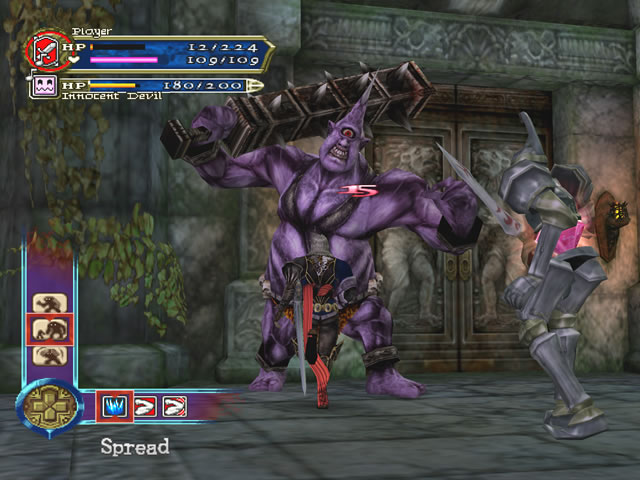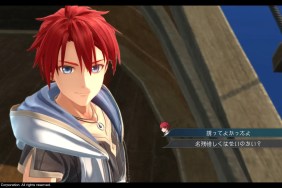No sympathy for this devil.
My name is Russ and I’m an addict. At 13 I bought an NES and the original Castlevania; ever since, the Belmont clan has been on my back like a whip-wielding monkey, urging me ever onward through pretty much every single Castlevania release. So after demolishing the excellent Dawn of Sorrow on the DS I turned to this, the fourth official 3D episode, with open arms.
But like that errant shot of whiskey at the end of a long night, this one’s a mistake. If I’d saved Dawn for dessert, Castlevania: Curse of Darkness would just seem like an average meal. After a thirty-hour reminder of how good this series can be, however, Curse of Darkness at best plays like a misguided effort.
Because there are only so many Draculas to slay and Belmonts to do it, the hero this time is Hector (who looks a lot like Alucard from Symphony of the Night), one of two executive assistants to Dracula before he was killed. But Hector rebelled, and while Drac isn’t around to give him crappy resume references, Isaac, his other former employee, is. Isaac is a redhead crawling with chains and tattoos; if he seems familiar, that’s probably because you last saw him playing keyboards for Nine Inch Nails during Fragility 2.0.
Isaac is also stereotypically (and comically) effete. Are Capcom and Konami trying to out-do one another with terrible characterization? If Capcom’s last shot was Devil May Cry 3, this is the rebuttal. Between Isaac, the laughably angry Hector and loads of other hopeless characters, every cutscene is a chore.
Unfortunately, the gameplay isn’t much better. Curse of Darkness picks up right where 2003’s Lament of Innocence left off, changing the core very little. This is a long, bland level grind. The combat isn’t very challenging; button-mashing will carry most players through the bulk of the action. There are differences, however, some of which are even good additions to the series.
New feature number one: both Hector and Isaac can forge demons. Because Hector is the hero, he forges ‘Innocent Devils’ instead of demons, and these function as the primary addition to Curse‘s gameplay. An Innocent Demon might be a fairy with healing powers, a magma-powered brute or an airborne assistant. They help out in battle, and each also has a useful ability that allows Hector to progress to new areas. Although you don’t directly control the devils, you can issue one of four basic A.I. commands, which they generally follow well enough. It’s a pretty cool system.
New feature number two: Hector makes his own gear, favoring swords and other weapons instead of the classic Belmont whip. Most have to be forged from metal and other items found throughout the game. It’s a good system, obviously a companion to the way souls upgrade items in Dawn of Sorrow. Because ingredients can be limited, players might have to choose whether they prefer a fast sword or a lumbering axe, lending some depth to the mashing.
A chosen weapon can also “change” Hector’s helper bees. Enemies will frequently drop weapon essences, and these cause the Innocent Devils to evolve in new directions. Sword essences will create faster, more offensive assistants, while other weapons twist the devils into other shapes.
 Such interesting new features might make you optimistic about Curse of Darkness, but those good feelings will be replaced by angry curse words due to the bad underlying design. I’ve gotten used to the fact that in 3D Castlevania, enemies look thick and ugly. Even the skeletons are chubby. I’ve come to accept the muddy textures and garish colors, both of which seem to mock the elegant 2D design found on the GBA and DS.
Such interesting new features might make you optimistic about Curse of Darkness, but those good feelings will be replaced by angry curse words due to the bad underlying design. I’ve gotten used to the fact that in 3D Castlevania, enemies look thick and ugly. Even the skeletons are chubby. I’ve come to accept the muddy textures and garish colors, both of which seem to mock the elegant 2D design found on the GBA and DS.
But someone new to the series might wonder aloud when their console was replaced with a PSOne. They’d be right to ask. Within an hour I was sick of wandering around corridors that all looked the same. It doesn’t matter if they’re in a castle or a mountain canyon; only a member of the development team will be able to tell the difference. The camera doesn’t help matters, always entering a room at the wrong angle with a focal length that makes the space feel cramped, no matter the actual size.
As Hector creates new Innocent Devils, he’ll be able to open previously locked rooms. Thanks to the bad visuals, it’s easy to get lost while backtracking. Hector might enter a room with four doors, then turn around a few times while killing monsters. Now which way did he come in? Good luck answering, because it all looks the same. Contrast that with the clear progression and unique rooms of a 2D Castlevania, where it’s impossible to get lost, and you’ll soon wish you had a DS in your backpack.
Konami obviously realizes that the 3D aesthetic makes Curse harder to play. Why else bring back the colored arrows that pointed the way forward in Lament of Innocence? Glowing pathways were lame then, they’re lame in Perfect Dark Zero, and here? Yeah. Lame.
 The dev team has also provided a means to mark locations on the game map and not one but two methods for teleporting to earlier spots, in an attempt to minimize the backtracking. Instead of adding these features to get around aspects of crappy gameplay, how about improving the basic engine?
The dev team has also provided a means to mark locations on the game map and not one but two methods for teleporting to earlier spots, in an attempt to minimize the backtracking. Instead of adding these features to get around aspects of crappy gameplay, how about improving the basic engine?
One arguable improvement is a target lock that can be toggled on or off. It has its moments, but most of the time it’s counter-productive. In large groups of enemies, it erratically locks on to things, leading to camera movement that can be sickeningly vertiginous. At best, it’s just hard to see what’s going on around Hector. The only times the system is useful is against airborne foes, bosses and when Hector needs to steal an item.
Stealing is the best way to get extra swag. Without light fingers, Hector will never get the game’s best weapons, assuming anyone cares enough to try. The number of secrets and hidden levels is the only feature that really feels like Castlevania. Indomitable players will be able to explore as original hero Trevor Belmont and will encounter Symphony of the Night‘s Legion, one of the sickest bosses in gaming. We appreciate the Easter Eggs, but most of the effort is wasted since the game isn’t compelling enough to demand your attention for that long.
For the determined vampire hunter, Castlevania: Curse of Darkness can be engaging, but only in the manner of any item-heavy level grind. The one driving force is the novelty of new weapons. Within a couple of hours you’ll realize that the level design, scripting and combat are still problematic in 3D and aren’t getting any better. Not long ago, producer Iga cut the first two 3D titles out of official continuity. I’m going to save him the trouble and cut out Curse of Darkness myself.
-
Innocent Devils are better than Pokemon
-
Hands-on weapons system
-
Now featuring a target lock…
-
…that barely works.
-
Ugly, dull and repetitive
-
Camera problems
-
Unrewarding level grind







